PRUNING FRUIT AND NUT TREES
by Jerry Parsons, Ph.D.
Horticulture Specialist, Texas Agricultural Extension Service
in San Antonio
Most of us take so much pride in growing our
fruit trees and vines that the thought of cutting on it thoroughly
horrifies us. Of course, if we truly "love" our
plants we will take the appropriate action to ensure that
they will be capable of a peak production performance when
the time comes. This "appropriate action" to which
I refer is pruning. Homeowners must be brave! Pruning a "loved"
tree or vine is sort of like spanking your child; you know
it's going to be best for all parties concerned.
Now is the proper time to prune. We need to
wait until winter is almost over (we hope) and spring is fast
approaching. Since our average first frost-free day is around
March 15, this month can be thought of as our early spring
month. Homeowners should not prune when wood is frozen since
freezing causes brittle wood. The main reason for not pruning
in the fall or winter months is that the possibility exists
of selecting poorly matured wood for main branches. This poorly-matured
wood may then die in the winter causing a reduced yield in
the next growing season. After winter exposure this dead wood
can be easily recognized as dark, brittle and sapless and
can be removed. Late spring pruning may cause sap bleeding
or weeping, but it is best to prune late than not to prune
at all.
Why prune at all? There are several very important
reasons why we should prune. First of all, pruning promotes
large, well-flavored fruit. This is very easy to understand
if one envisions the entire metabolic workings of a tree or
vine. Remember, plants are like people --they have certain
limitations. It is impossible for a plant to produce the quality
of fruit which we desire when it is allowed to mature the
quantity of fruit which it is capable of setting. For this
reason, we must control the tree's fruiting. By proper pruning
techniques, we can remove some of the fruit buds which would
mature fruit. By having to mature fewer fruit the tree can
concentrate all available nutrients into those few fruit and
consequently produce the large, juicy product which we desire.
The fruit grower must decide whether he wants many small fruit
or an adequate number of high-quality fruit. That plant only
has a certain capacity for production.
Another valuable advantage of pruning is to establish a proper
framework. A strong framework can support more fruit which
should be evenly distributed throughout. This will prevent
tree breakage when fruit begins to grow and mature. The even
distribution will also enhance an even ripening of fruit throughout
the tree. Of course, we all realize that prevention of tree
breakage will result in a longer-living and more attractive
landscape plant.
One of the most often overlooked, and possibly
the most important, aspects of proper pruning is the fact
that pruning serves to modify growth conditions. This simply
refers to a previous statement that plants, like people, are
capable of only so much production. The production of a plant
during the growing season largely depends upon the vigor of
the plant during the preceding year. If a tree or vine is
allowed to overproduce, which will be caused by pruning neglect,
a smaller amount of shoot growth and metabolite storage will
occur. It will be weakened, and normal production will be
decreased in the following year.
I have not told you exactly how to prune the
different fruit and nut trees. That is because each tree is
an individual and requires a different approach. Each pruner
is different and wants a certain product or shape in his tree.
There are books and publications which give general recommendations,
and I would encourage you to get these if you have some plants
to prune. Following are pruning descriptions of the most common
fruit.
What is so frustrating about fruit tree pruning is the fact
that each tree is different and therefore requires an entirely
different pruning judgment. I am attempting to give you a
generalized plan from which you can deviate as needed. The
following are some summaries of a few fruit pruning techniques:
APPLE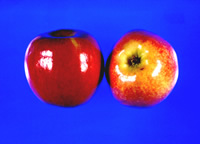
Pruning
young trees tends to dwarf or retard growth. Nevertheless,
this is an important practice for the young tree to get the
right start. To prune properly, a definite objective is necessary.
Trees may be trained in many different forms.
The popular form of the apple tree today is the central leader
type. Its chief characteristic is the central trunk with scaffold
branches growing from it. One of the best examples of the
leader type is the pine tree.
The trunk should be definitely larger than
the branches, and the branches should be well separated up
the trunk. The lowest branch should be 2 to 3 feet from the
ground, but this is a matter of personal choice.
A variety with wide-spreading branches should
have the first branch starting higher than one with upright
branches.
If non-branched trees are planted, cut them
24 inches above the ground at planting time.
Two year-old trees received from the nursery
will have several branches, each not more than about 3 inches
apart. Cut off all but one of these leaders. If there are
two or three leaders, they form narrow v crotches where they
join. Such crotches are weak and tend to break in a storm
or under a heavy crop of fruit.
After choosing one leader, select the first
or lowest branch for your tree. It is important that all these
scaffold branches have wide angles where they join the trunk.
The first year of training usually produces
a tree with one branch -occasionally two -and a leader. Cut
back very long leaders to about 20 inches. New lateral branches
will grow from the leader next year. From these you can choose
another scaffold branch or two. As the tree grows older and
higher, cut the top off at about 10 feet. Make such a cut
at the junction of a lateral branch. This form is then known
as the modified leader.
Five to eight scaffold branches are enough
for a tree. The space between branches should be 8 to 18 inches,
and the branches should be evenly distributed around the central
trunk. If certain branches are longer than the others, prune
them back severely. When the permanent scaffold branches are
selected, it is permissible to let other branches grow. Remove
these branches in a year or two before they interfere with
proper development of the permanent branches. Avoid branches
with narrow crotch angles, if possible.
PEARS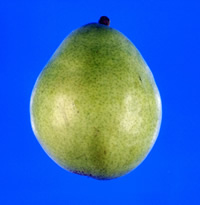
Train the young pear tree at planting to the
same pattern as recommended for apples.
Once the young pear tree is established, prune only lightly.
The branches of most pear varieties and some apple varieties
tend to grow upright, so they need to be spread and pulled
down. Cutting back to outward buds or shoots is not a good
way to do this, because soft new growth is subject to fire
blight.
To spread the tree put wooden "spreaders"
in or near the crotches or tie the branches down or outward.
Pear trees are very slow to begin bearing. As trees reach
5 to 6 years of age, such tying down or bending of the upright
branches tends to start fruit buds.
PLUMS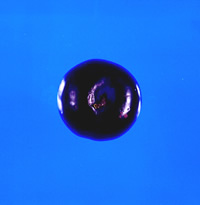
Young plum trees should be trained in much
the same way as peach trees.
The newly planted trees should be pruned in
the spring just before growth begins. If non-branched trees
are planted, cut off the shoot about 3 feet above the ground.
If branched trees are planted, one or two branches with the
lowest about 2 feet from the ground are selected, as the beginning
of the main scaffold limbs. Avoid heavy pruning of plums.
APRICOTS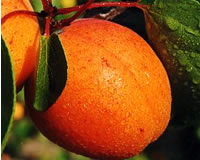
Apricots are usually pruned very little since
they fruit so sporadically. Apricots are borne on short spurs
and one year old growth. Considerable thinning-out pruning
should be done to induce annual production of new fruiting
wood.
GRAPE
Because of the grape vine's characteristic of vigorous growth severe
pruning isnecessary. Approximately 90 percent of the entire
vine must be removed yearly. You will benefit by harvesting
larger grapes, and the vine will benefit by increased and
maintained vigor.
PEACH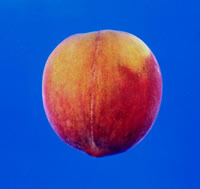
Peach trees are trained or grown using an open
center system. To accomplish this, three limbs radiating in
120-degree directions from the uppermost part of the trunk
are selected for primary scaffold branches . The lowest scaffold
branch should be 18-20 inches from ground level and pointing
in the direction of the southwest. This shades the ground
and trunk from intense sunlight. Enough trunk space should
be left so that there will be 8-12 inches of trunk between
primary scaffold branches.
If all primary scaffolds emerge from the trunk
near the same location, a danger exists of splitting the trunk
and ruining the tree when a heavy crop of fruit is produced.
Proper spacing of scaffolds, selection of wide angle crotches,
and removal of conflicting and upright branches develop a
strong framework to support heavy loads of fruit.
Secondary branching on main scaffolds should be encouraged
by heading or cutting these main scaffolds at 20 to 30 inches
from their juncture with the trunk. After these primary scaffolds
have formed, secondary branching , light pruning or heading
each session will cause new growth in the form of tertiary
branches which will bear most of the fruit.
Once this main system of primary, secondary,
and tertiary branches has been developed, subsequent pruning
will consist of cutting back tall shoots, keeping the center
of the tree open, and removing all suckers, watersprouts,
dead or diseased branches, and rubbing or shading branches.
The tree should not be allowed to grow higher than 8 feet.
The "maintenance work" on a peach
tree should consist of thinning out undesirable growth, especially
that which grows in and toward the center of the tree. In
fact, a good technique for pruning peaches is to stand in
the center of the tree and prune until you have a bowl or
open center effect around you. Each of the six secondary scaffold
limbs, when pruned back, will produce additional fruiting
limbs around the perimeter of the tree. Center limbs and low-hanging
outside limbs should be removed.
For another simple description of peach pruning, see:
http://aggie-horticulture.tamu.edu/newsletters/hortupdate/hortupdate_archives/2002/mar02/art8mar.html
PRUNING ORNAMENTAL PLANTS
Pruning is a horticultural practice based on
aesthetics and science that alters the growth of a plant.
There are many reasons for pruning, and all pruning should
be based on reason.
Pruning often begins at planting time for bare
root nursery stock. However, recent research indicates that
it is better to do only minimal corrective pruning then. Some
guidelines for pruning are: (1) Broken and damaged roots should
be pruned back to sound wood, (2) Broken and damaged branches
should be removed, (3) Young trees can be shaped. It is usually
not advisable to cut back the leader of a young tree, (4)
The stems of shrubs can be thinned and partially cut back,
(5) Plants to be grown as hedges should be cut to within 6
inches of the ground at planting time.
It is usually not necessary to prune plants that are dug with
a ball of soil attached to their roots.
Pruning can maintain the health and quality
of established plants. Pruning for the following reasons will
help prolong the plant's life by: (1) removing dead or dying
portions of plant with disease problems or insect injury,
(2) removing portions of plant injured or killed by the winter,
(3) removing branches injured by storms, (4) removing existing
branch stubs, (5) removing rubbing branches, (6) removing
sprouts or suckers at the base of grafted plants, (7) removing
watersprouts (succulent vigorous shoots on the inside of the
tree near the trunk), (8) removing surplus branches so the
remaining ones are spaced at 1 foot apart on trees, (9) branches
normally should be left so they come out from all sides of
the tree, (10) removing narrow-angled branches from the main
trunk.
Another reason for pruning is to improve the
appearance of the foliage and flower and stem quality as well
as to: (1) shape or form and increase the usefulness of function
of the plant, such as hedges, espalier, etc., (2) remove lower
branches to train to tree form, (3) remove multiple leaders
on these plants where a single leader is desired, such as
evergreen or shade trees, (4) control plant size, and (5)
improve fruit quality and increase production, open plant
up, and promote flowering, ease of spraying, and harvesting.
Pruning is sometimes done to protect people
and property rather than to benefit the plants. For example,
pruning is done to: (1) eliminate weak tree branches that
overhang homes, parking areas, and other areas that are frequented
by people, (2) eliminate branches that interfere with street
lights and traffic signals, (3) remove branches that interfere
with overhead wires, (4) remove lower branches that are a
safety hazard or interfere with individual or vehicular movement
and (5) prevent encroachment on others' property.
Pruning at the proper time is also important.
Some plants are susceptible to disease invasion if pruned
at the wrong time. These plants should be pruned when they
are least likely to become infected.
1. Oaks should be pruned during December, January,
or February to minimize the chance of oak wilt infection,
a fungus disease. (Any summer pruning necessitated by storm
damage should be covered immediately by a wound dressing.)
2. Apples, and pears, should be pruned between
the time they go dormant in the fall and the time growth starts
in the spring to minimize the spread and chance of infection
by a bacterial disease called fireblight.
Some trees have a free flowing sap and will
"bleed" if pruned in late winter or early spring.
Although this "bleeding" causes little or no harm
to the plant, it causes major concern for many homeowners.
Trees and shrubs that bloom early in the growing
season on old wood should be pruned immediately after they
finish blooming. Any winter injury should be eliminated as
soon as the following plants come into leaf.
Shrubs that bloom late but on old wood should
be pruned either early in the spring before growth starts
or immediately after bloom.
Shrubs grown primarily for their foliage, fruit,
or other reasons should be pruned in the spring before growth
starts. Any wood injured by the winter should be removed as
soon as the plant comes into leaf.
Shrubs that bloom on the current season's growth
should be pruned in the spring before growth starts.
The natural form of an evergreen is usually
the most desirable, and pruning should be limited to correcting
growth defects. Evergreens that grow continuously through
the growing season can be pruned at any time, but early in
the growing season is usually best.
Pines put on a single flush of growth and stop.
They must be pruned at the candle stage of growth before the
candles become woody. Pruning at other times will cause dead
stubs. To promote dense, compact specimens, pines should be
pruned when their candles are elongated to about three-fourths
their length. Up to two-thirds of this new growth can be removed.
Pruning should not go into last year's growth.
Do not attempt to prune near electrical and
utility wires. The utility companies should be contacted to
do the work.
For most landscapes, the natural form of the
plants is best, and consequently plants should not be sheared
to tight geometrical forms. They should be altered only if
the plant must be confined or trained to a specific purpose.
After pruning, it should not be obvious that the plant has
been pruned.
Never leave stubs because these serve as entryways
for disease organisms to invade the plant. Heading back or
topping trees is not recommended because the cut stubs never
completely heal. It is often better to remove trees that have
outgrown their usefulness.
Overgrown shrubs can be renewed by cutting
off 1/3 of the oldest stems to the ground. When renewing an
overgrown hedge (most shrubs will recover), cut it to the
ground. Avoid partial cutback of shrubs.
In shortening a branch or twig, cut it back
to a side branch or make this cut 1/4 inch above a dormant
bud. Dormant buds are at the bases of all leaves.
When cutting roses, the stem should be cut
to ½ inch above the bud at the base of a 5-leaflet
leaf growing toward the outside of the plant. If pruned to
this point, bloom will occur more quickly than if a shorter
stem were removed.
When removing large branches, three or four
cuts are necessary to avoid tearing the bark. Make the first
cut on the underside of the branch about 18 inches from the
trunk. Undercut 1/3 to ½ way through the branch, but
stop before the saw binds. The second cut should be made an
inch further out on the branch; cut until the branch breaks
free. If the stub is small enough, hold it with one hand and
use the other hand to cut the branch stub. The cut should
be made just beyond the branch collar swelling. This collar
contains chemicals that inhibit the invasion of decay organisms.
If the branch is too large to be held in one hand, undercut
it with the third cut, and cut it through with the fourth
cut from the top down.
A newly planted hedge should be pruned to within
6 inches from the ground at planting time. At each succeeding
pruning, it should be pruned to within 1 inch to 2 inches
from the last pruning to develop a dense plant. Hedges should
be pruned so they are wider at the base than at the top to
allow all parts to receive sunlight.
For a COMPLETE listing of landscape plants and
how to prune them properly, see:
http://aggie-horticulture.tamu.edu/earthkind/landscape/proper-pruning-techniques/



